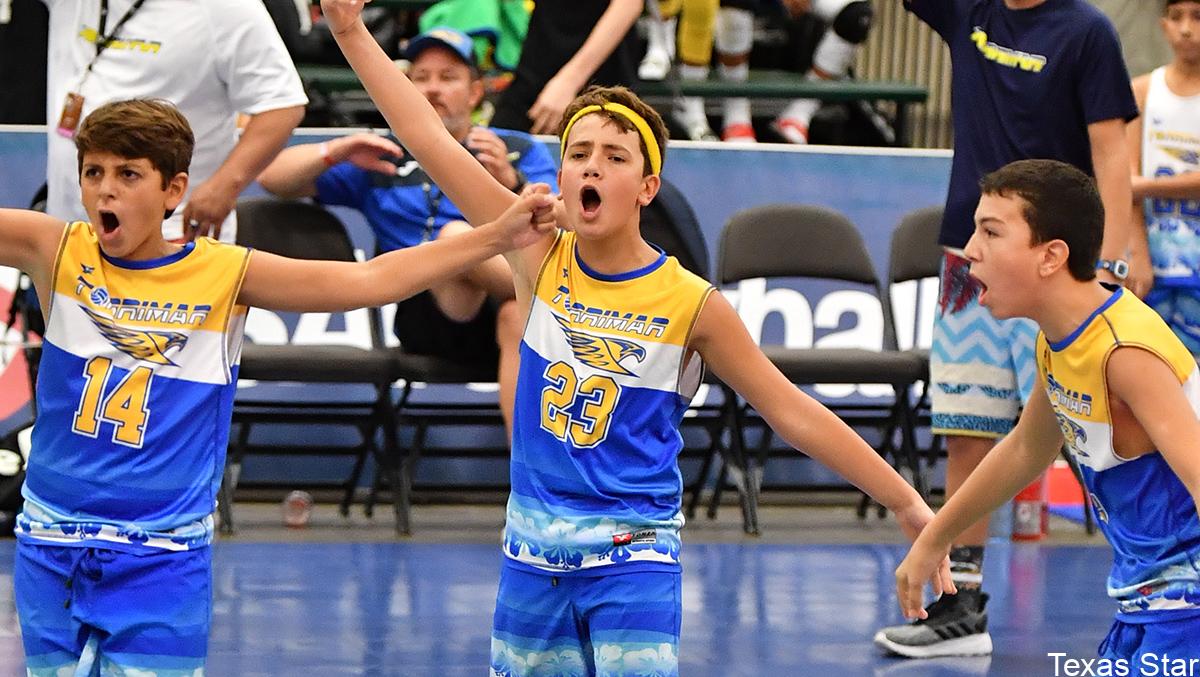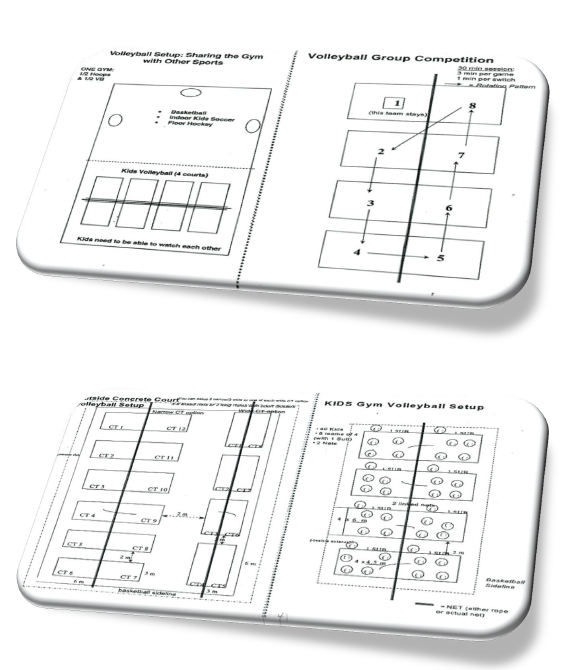
After nearly 40 years of spending time coaching 12U, I though it might be of value to share some of the best ways to grow the game, which should start at this 6-12 year-old age group level. Most of these secrets I have already put into the books I have written to help our sport at the starting level – Minivolley Book and IMPACT books by USA Volleyball. There are, however, a few core concepts/ideas I believe worth re-sharing and elaborating on even more.
1. Fitting in volleyball with basketball and other sport programs
2. Finding enough coaches
3. Coaching the youngest, 3-9-yearolds
4. Grills for little kids
FITTING VOLLEYBALL INTO OTHER SPORTS
Recently a coach asked about her challenges of finding space to run volleyball during basketball season. The answer is seen in the drawings below, where you ask the basketball-focused facility, for just ONE court, not the gym, just part of it. For youth volleyball you can put three to four courts up on a single regular court space, using the four nets on a rope we have created.

A nice example of how you can take one adult doubles outdoor court space and turn it into four kids nets: Run the kids nets down the middle of the adult court (serving line to serving line), this would make each court about 15 feet wide. You could also make two full-size courts by pulling two kids nets together, creating two adult courts on each side.
Working with the wall rope standard of the Maximum Contact Net System allows six sports on one system, this system can also be built outdoors using two by fours. Those sports, with net heights are:
- Volleyball, for older kids, six feet six inches (200 cm)
- Volleyball, for younger kids, five feet (152.4 cm)
- Badminton five feet (152.4 cm)
- Tennis three feet (91.5 cm)
- Sitting Volleyball, for men, three feet nine and a quarter inches (115 cm)
- Sitting Volleyball, for women, three feet seven and a quarter inches (110 cm)
- Pickleball three feet (91.5 cm)
If you use three of the four nets in the Maximum Contact Net System, you can use the fourth net to set up wallyball in a racquetball court. A racquetball court is also perfect for setting up a single sitting volleyball court. The great thing in this, both the fun of wallyball or sitting, is that you get back on track fast because the ball does not get away. Also, you could opt to put this net into a corner of the a gym with deer netting to catch and return spiked balls.
Here are some options for you to execute the above ideas:
Long rope
1.5-2.5 inch ribbon – wire edged
Maximum Contact Net System
Regular Net, divided into narrow courts by swim noodles
Another idea is, to train at different times. I used to coach high school ice hockey. Our parents would bring their athletes to the rink for 11 p.m. practice and the next day they brought them to our 5 a.m. ice time. Traditionally, swimming has also trained before sunrise. Why can’t some of your older players train later or earlier too?
FINDING ENOUGH COACHES
Recent youth sports models show the need for more “coaches” including strength coaches, mental coaches, agility coaches, assistant coaches, personal trainers, nutritionist, and more. This model would make the player to coach ratio for individual sports eight to one and for team sports, like volleyball, one to one. However, for youth sports I would like you to consider what a great PE teacher can do, as well as the value of open gym and uncoached play. I have to say I am a great admirer of golfer Bubba Watson, who won the Masters in 2014, because in all his years of youth development he did not have a coach.
When the ever important open gym can happen there is no “coach” other than the game teaching the game and the kids develop their leadership, organizational, and decision making skills without being told what to do. I think programs should do more open gym times than they do right now. Also, if you look at elementary PE teachers, they handle a class ratio much higher than other coaches, so let the kids gather and just have some adult oversight, good things will happen.
At the same time, since that which you teach you learn, every club program has dozen of “coaches” waiting to improve their coaching skills. I think this is a vastly underdeveloped area in growing our sport and ask clubs, no matter what their size, work this into their programming.
COACHING THE YOUNGEST PLAYERS (3 TO 9 YEAR OLDS)
Earlier, I wrote about PE teachers as they both introduce and teach literally dozens of sport options. I think this is a missing part to youth volleyball programs is the chance to experience and learn of other sport options. Both Olympic and non-Olympic sports need to be introduced by doing them as a “warm up” or break in the volleyball training session. For the youngest levels, this can be done in “movement” training sessions as youth sports programs become a place to learn how to move ones own body. Creating a movement discovery adventure in a volleyball training session for little kids is easy, just ask the kids to challenge each other in “can you do this?” games and tag games. Give them various sized balls and foam noodles and throw in some taped court challenges.
For example, you can make hop scotch, dodge ball courts and “hurdles.” If you visit your local elementary school PE teacher and ask them to show you around their equipment closet and explain what they have in there, you will see tons of great ideas a club can implement, along with a volleyball program for that school. Also remember, this where parents can also be teammates, not coaches. Parents can go outside and play two verse two over a rope, one verse one, or loser becomes the “net.”
GRILLS FOR LITTLE KIDS
Kids want to play, you can see that at recess and in the parking lots and hallways of tournaments. When asked, “do you want to do a game or a drill? ” they will always want a game. This is why it is important to do grills (game like drills) with scoring. Also, just let them play. Let them create the way they want to score or from the Minivolley Book. Remember, how you learned tag games? Did you learn from drills? No, you learned by playing. The circulation version stops specialization, your side rotates during every play, every time the ball crosses the net. Consider maxi scoring, know in Canada as three ball scoring, and many more options found in the MiniVolley book that let them play and learn competitively and cooperatively.
The game of choice, when a net cannot be found, is to have the “loser” of the previous point become the “net.” This can be played with three to twelve kids, in speedball or monarch of the court fashion. The “net” cannot jump, but they can turn and face each sides team and be an active, blocking/reaching net. Other grills videos can be found here.

